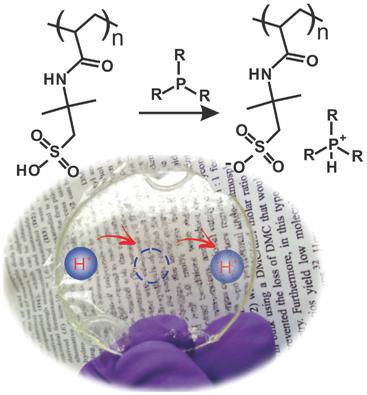当前位置:
X-MOL 学术
›
Macromol. Rapid Commun.
›
论文详情
Our official English website, www.x-mol.net, welcomes your feedback! (Note: you will need to create a separate account there.)
Proton Conducting Membranes Based on Poly(Ionic Liquids) Having Phosphonium Counter‐Cations
Macromolecular Rapid Communications ( IF 4.6 ) Pub Date : 2017-12-04 , DOI: 10.1002/marc.201700627 Mehmet Isik 1 , Luca Porcarelli 1 , Nerea Lago 1 , Haijin Zhu 2, 3 , Maria Forsyth 2, 3 , David Mecerreyes 1
Macromolecular Rapid Communications ( IF 4.6 ) Pub Date : 2017-12-04 , DOI: 10.1002/marc.201700627 Mehmet Isik 1 , Luca Porcarelli 1 , Nerea Lago 1 , Haijin Zhu 2, 3 , Maria Forsyth 2, 3 , David Mecerreyes 1
Affiliation

|
Proton conducting polymeric membranes are highly searched in many different technologies ranging from energy to biosensing. Protic ionic liquids and their polymeric version represent a new family of proton conducting molecules with relatively facile synthesis and excellent properties. In this work, protic poly(ionic liquids) having the most popular phosphonium counter‐cations are presented for the first time. The synthesis is carried out through proton transfer reactions or through ion exchange reactions by using commercially available tertiary phosphines. Tributyl‐, trioctyl‐, and tricyclohexyl‐phosphine are selected to form the desired cations. Polystyrene sulfonic acid, poly(2‐acrylamido‐2‐methyl‐1‐propanesulfonic acid), and lithium poly[(4‐styrenesulfonyl) (trifluoromethanesulfonyl)imide] polymers are used to form the polymeric anions. The chemical structure of the protic poly(ionic liquids) is confirmed by spectroscopic characterizations such as Fourier transform infrared and nuclear magnetic resonance spectroscopies. Thermal properties of the polymer are characterized by means of differential scanning calorimetry and thermogravimetric analysis. Polymers exhibit good membrane forming ability as well as high ionic conductivities in the range of 10−8 to 10−3 S cm−1 from 30 to 90 °C.
中文翻译:

基于具有磷反阳离子的聚离子液体的质子传导膜
质子传导聚合物膜在从能量到生物传感的许多不同技术中都得到了高度研究。质子离子液体及其聚合形式代表了新的质子传导分子家族,具有相对较容易的合成和优异的性能。在这项工作中,首次提出了具有最普遍的counter反阳离子的质子性聚(离子液体)。合成是通过使用可商购的叔膦通过质子转移反应或通过离子交换反应进行的。选择三丁基,三辛基和三环己基膦形成所需的阳离子。聚苯乙烯磺酸,聚(2-丙烯酰胺基-2-甲基-1-丙烷磺酸)和聚[(4-苯乙烯磺酰基)(三氟甲磺酰基)酰亚胺]锂聚合物可用于形成聚合阴离子。质子聚(离子液体)的化学结构通过光谱表征(例如傅立叶变换红外光谱和核磁共振光谱学)得到证实。聚合物的热性质通过差示扫描量热法和热重分析法来表征。聚合物表现出良好的成膜能力以及高离子电导率(在10的范围内)从30到90°C为-8至10 -3 S cm -1。
更新日期:2017-12-04
中文翻译:

基于具有磷反阳离子的聚离子液体的质子传导膜
质子传导聚合物膜在从能量到生物传感的许多不同技术中都得到了高度研究。质子离子液体及其聚合形式代表了新的质子传导分子家族,具有相对较容易的合成和优异的性能。在这项工作中,首次提出了具有最普遍的counter反阳离子的质子性聚(离子液体)。合成是通过使用可商购的叔膦通过质子转移反应或通过离子交换反应进行的。选择三丁基,三辛基和三环己基膦形成所需的阳离子。聚苯乙烯磺酸,聚(2-丙烯酰胺基-2-甲基-1-丙烷磺酸)和聚[(4-苯乙烯磺酰基)(三氟甲磺酰基)酰亚胺]锂聚合物可用于形成聚合阴离子。质子聚(离子液体)的化学结构通过光谱表征(例如傅立叶变换红外光谱和核磁共振光谱学)得到证实。聚合物的热性质通过差示扫描量热法和热重分析法来表征。聚合物表现出良好的成膜能力以及高离子电导率(在10的范围内)从30到90°C为-8至10 -3 S cm -1。


























 京公网安备 11010802027423号
京公网安备 11010802027423号